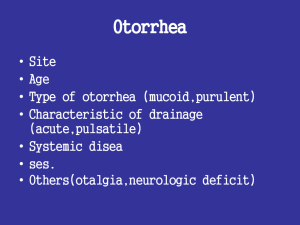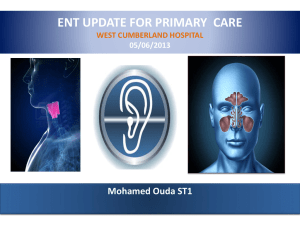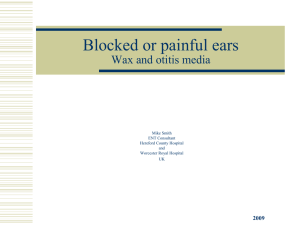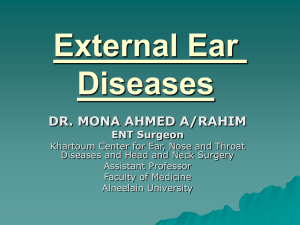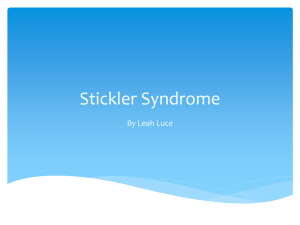Approach to Ear Problems
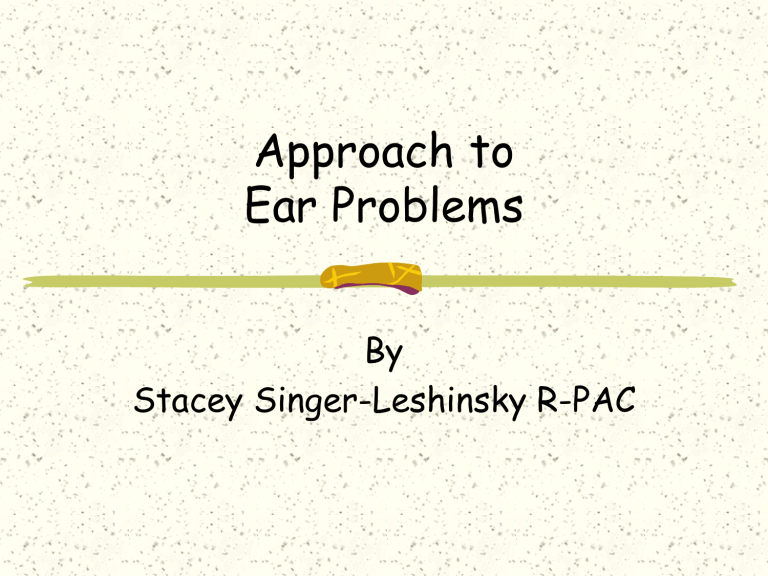
Approach to
Ear Problems
By
Stacey Singer-Leshinsky R-PAC
Includes:
Disease of the external ear
Disease of the middle ear
Disease of the inner ear
Normal TM
External Auditory Canal
Otitis Externa
Defenses include cerumen which acidifies the canal and suppresses bacterial growth.
External Auditory Canal
Otitis Externa
Cerumen prevents water from remaining in canal and causing maceration.
Etiology: Pseudomonas aeruginosa and staphylococcus aureus, strep
External Auditory Canal
Otitis Externa
Risk factors for Otitis Externa include:
Swimming, perspiration, high humidity, insertion of foreign objects,
Eczema, psoriasis, seborrheic dermatitis
External Auditory Canal
Otitis Externa-Clinical manifestations
Otalgia/otorrhea
Fever
Pain
Canal edematous and obscured with debris, discharge, blood, or inflammation
Lymphadenopathy
External Auditory Canal
Otitis Externa-
Complications malignant otitis externa caused by pseudomonas
Differential diagnosis basal cell carcinoma squamous cell carcinoma
External Auditory Canal
Otitis Externa-Management
Topical antibacterial drops such as
Neomycin otic, polymyxin, Quinolone otic
Otic steroid drops containing polymyxin-neomycin and a topical corticosteroid.
Analgesics
External Auditory Canal
Otitis Externa-Management
Discuss patient education issues such as:
Swimmer prophylaxis contains acid and alcohol
External Auditory Canal
Chronic Otitis Externa
Duration of infection greater than four weeks, or greater than 4 episodes a year
Risks: inadequate treatment of otitis externa, persistent trauma, inflammation or malignant otitis externa.
Etiology: Bacterial,fungal or dermatologic such as candida or Aspergillus, pseudomonas or psoriasis
External Auditory Canal
Chronic Otitis Externa
Purulent discharge
Dry or scaly.
Pruritus
Conductive hearing loss
Diagnosis:
External Auditory Canal
Chronic otitis externa-Management
Cover fungi with clotrimazole(Lotrimin)
Systemic antifungal include ketoconazole
Cortisporin
Wick with few drops of Domeboro’s astringent
Differential diagnosis to include basal cell or squamous cell carcinoma, Foreign bodies, otitis media
External Auditory Canal
Malignant Otitis Externa
Inflammation and damage of the bones and cartilage of the base of the skull
Occurs primarily in immunocompromised
Most common etiology is pseudomonas aeruginosa.
External Auditory Canal
Malignant Otitis Externa
Otorrhea: yellow green, foul smelling.
Granulation tissue in external auditory canal
Trismus
Fever
Facial and cranial nerve palsies
External Auditory Canal
Malignant Otitis Externa
Diagnosis: Culture of ear secretions and pathological examination of granulation tissue, CT
Complications include sepsis, cranial nerve palsies, meningitis, brain abscess, osteomyelitis of the temporal bone and skull
Differential diagnosis to include basal cell or squamous cell carcinoma
External Auditory Canal
Malignant Otitis Externa
Need IV antibiotics
Might need surgical debridement.
If treatment interrupted rate of recurrence is 100%
External Auditory Canal
Cerumen Impaction
Cerumen is produced by apocrine and sebaceous glands in external ear canal.
Often caused by attempts to clean the ear, or water in canal
Cerumen is pushed down
Cerumen Impaction
Clinical Manifestations
Hearing loss
Stuffed or full feeling to ear
Pain if cerumen touches TM
External Auditory Canal
Cerumen Impaction
Be sure TM is intact prior to lavage
Irrigate ear with one part peroxide, and one part water
Debrox and Cerumenex drops
Ear irrigation and manual cerumen removal
External Auditory Canal
Foreign body
Can include toys, beads, nails, vegetables or insects.
Damage depends on amount of time object has been in ear.
External Auditory Canal
Foreign body-Clinical Manifestations
Might present with purulent discharge
Pain
Bleeding
Hearing loss
External Auditory Canal
Foreign body
Complications include internal injury
Differential diagnosis to include cholesteatoma, cerumen impaction, otitis externa
External Auditory Canal
Foreign body- Management
Irrigation is best provided the TM is not perforated
Destroy insect with lidocaine or mineral oil.
Irrigate and suction liquid.
For inanimate objects suction or use alligator forceps.
Tympanic Membrane
Bullous Myringitis
Vesicles develop on the TM second to viral infections or bacterial infection
Usually associated with middle-ear infection
May extend into canal.
Tympanic Membrane
Bullous Myringitis- Clinical Manifestations
Sudden onset of severe pain
No fever usually
No hearing impairment
Bloody otorrhea possible
Inflammation to TM
Multiple reddened inflamed blebs possibly blood filled
Tympanic Membrane
Bullous Myringitis
Differential diagnosis to include squamous or basal cell carcinoma, acute otitis media
Complications
Tympanic Membrane
Bullous Myringitis-Management
Antibiotics
If pain is severe, rupture the vesicles with a myringotomy knife
Analgesics
Tympanic Membrane
Perforated TM
Etiology is direct trauma, infection, pressure build up
Bacteria can travel into middle ear and lead to secondary infection
Tympanic Membrane
Perforated TM- Clinical
Manifestations
Sudden severe pain
Hearing loss
Drainage
Otoscope exam reveals puncture in TM, might be able to see bones of middle ear
Purulent otorrhea may begin in
24-48 hours post perforation
Tympanic Membrane
Perforated TM
Differential diagnosis to include acute and chronic otitis media
Complications include secondary infection into inner ear
Tympanic Membrane
Perforated TM-Management
Antibiotics to prevent infection or treat existing infection
Surgical repair
Middle Ear
Acute Otitis Media
Viral respiratory infections cause inflammation of ET
When ET is blocked, fluid collects in the middle ear.
Middle Ear
Acute Otitis Media
Common in fall, winter or spring
ET in child is shorter and more horizontal in infants/children.
Bacterial Etiology : S.pneumoniae,
H.influenzae, and M.Catarrhalis.
Risks include URI,smoking at home, allergies, cleft palate, adenoid hypertrophy, bottle feeding, barotrauma
Middle Ear
Acute Otitis Media
Otalgia.
Conductive hearing loss
URI symptoms
Vomiting, diarrhea
Fever
TM bulging and erythematous with decreased or poor light reflex.
Decreased TM mobility on pneumatic insufflation
Middle Ear
Acute Otitis Media -Diagnosis
Tympanometry
Differential diagnosis to include TM perforation, Tympanosclerosis, recurrent AOM, mastoiditis
Middle Ear
Acute Otitis Media
-Management
Analgesics/ Antipyretics
Auralgan
Antibiotics
Trimethoprim-sulfamethoxazole or Azithromycin
Decongestants:
Avoid antihistamines
Middle Ear
Acute Otitis Media –Patient Education
Myringotomy in patients with hearing loss, poor response to therapy or intractable pain
Discuss patient education issues including breast feeding, no smoking in homes, pneumococcal vaccine
Middle Ear
Acute Otitis Media
-Complications
TM perforation/ Tympanosclerosis
Recurrent AOM or chronic OM
Persistent middle ear effusion
Mastoiditis
Bacteremia
Middle Ear
Acute Otitis Media
-Recurrent OM
Three episodes of AOM in 6 months or 4 episodes in 12 months
Diagnosis
Prevent by antibiotic prophylaxis, pneumovax, tympanostomy tubes, adenoidectomy
Middle Ear
Otitis Media with Effusion
Fluid accumulation behind TM in middle ear
Build up of negative pressure and fluid in eustachian tube
Common in children because of anatomy, cleft palate, allergies, barotrauma.
Middle Ear
Otitis Media with Effusion
Hearing loss
Fullness, pressure
TM neutral or retracted. Gray or pink.
Landmarks visible or dull.
Decreased TM mobility
Middle Ear
Otitis Media with Effusion
Diagnosis
Tympanometry- most accurate,
Audiometry-
Differentials to include: Acute Otitis
Media, malignant tumors to nasal cavity, cystic fibrosis
Middle Ear
Otitis Media with Effusion
Management
Decongestants/Oral steroids
Antibiotics
Myringotomy with or without tubes
Adenoidectomy
Complications:
Middle Ear
Chronic Otitis Media
Recurrent or persistent otitis media due to dysfunctional eustachian tube
Risks: allergies, multiple infections, ear trauma, swelling to adenoids.
Bacteria: P aeruginosa, proteus
species, Staphylococcus aureus, and mixed anaerobic infections.
Middle Ear
Chronic Otitis Media
Causes long term damage to middle ear due to infection and inflammation including
Severe retraction of TM due to prolonged negative pressure
Scaring or erosion of small conducting bones of middle ear and inner ear
Erosion of mastoid
Thickening of mucous secretions in ET
Cholesteatoma
Persistent OME
Middle Ear
Chronic Otitis Media
Ear pain
Fullness to ears
Purulent discharge
Hearing loss
Dullness, redness or air bubbles behind TM
Middle Ear
Chronic Otitis Media
Diagnosis: clinical, audiometry, tympanometry, CT, MRI
Differential diagnosis to include
AOM, cholesteatoma
Complications include bony destruction or sclerosis of mastoid air cells, facial paralysis, sensineural hearing loss, vertigo
Middle Ear
Chronic Otitis Media-Management
Antibiotics , steroids, placement of tubes.
Myringotomy
Surgical tympanoplasty, mastoidectomy
Cholesteatoma
Epithelial cyst consists of desquamating layers of scaly or keratinized skin.
Erosion of ossicles common. As more material is shed, the cyst expands eroding surrounding tissue.
Two types: congenital and acquired.
Acquired due to tear in ear drum, infection
Cholesteatoma
Perforation of TM filled with cheesy white squamous debris
Possible conductive hearing loss
Drainage
Differential Diagnosis: squamous cell carcinoma
Cholesteatoma-Management
Large or complicated cholesteatomas require surgical excision
Complications include erosion of bone and promote further infection leading to meningitis, brain abscess, paralysis of facial nerve.
Barotrauma
Physical damage to body tissue due to difference in pressure between an air space inside or beside body and surrounding gas.
Ear barotrauma:
Barotrauma
Etiology is a change in atmospheric pressure. Negative pressure in the middle ear causes Eustachian tube to collapse.
Since air can not pass back through the ET, hearing loss and discomfort develop
Risk factors
Differential diagnosis should include serous, acute or chronic otitis media, bullous myringitis
Barotrauma
Hearing loss
Otalgia
Barotrauma-Management
Auto inflation by yawning, swallowing or chewing gum to facilitate opening of ET to equalize air pressure in middle ear
Decongestants
Myringotomy
Patient education to include valsalva maneuver.
Mastoid
Portion of temporal bone posterior to the ear.
Mastoid air cells connect with the middle ear
Fluid in the middle ear can lead to fluid in the mastoid
Mastoiditis
Middle ear inflammation spreads to mastoid air cells resulting in infection and destruction of the mastoid bone.
Etiology: Streptococcus pneumoniae,
Haemophilus influenzae, streptococcus pyogenes, and other bacteria
Mastoiditis
Pain
Bulging erythematous TM
Erythema, tenderness, edema over mastoid area
Postauricular fluctuance
Mastoiditis-
Diagnosis/differentials
Diagnosis:
CT show bony destruction or drainable mastoid abscess
Tympanocentesis to culture middle ear fluid.( S. pneumoniae, H. influenzae, M. catarrhalis)\
Culture of fluid
Differential diagnosis to include otitis media, Cellulitis, scalp infection with inflammation of posterior auricular nodes
Mastoiditis
Complications
Destruction of mastoid bone
Spread to brain leading to brain abscess or epidural abscess
Mastoiditis-Management
Treat with antibiotics
Patients with severe or prolonged
May need to surgically remove a portion of the bone
Labyrinthitis
Viral infection
Vestibular neural input disrupted to the cerebral cortex and brain stem
Vertigo due to inflammation and infection of labyrinth
Neurological exam normal
Can also follow allergy, cholesteatoma, or ingestion of drugs toxic to inner ear
Labyrinthitis
Nausea/vomiting
Vertigo with head or body movements lasts about 1 min
Nystagmus(rotary away from affected ear)
Loss of balance
Labyrinthitis-History and PE
Diagnosis: Audiologic testing, CT and
MRI
Differentiate other causes of dizziness by CT, MRI
Differential diagnosis to include acoustic neuroma, vertigo, cholesteatoma, meniere’s disease
Labyrinthitis-Management
Steroids
Sedatives
Antivert
Tigan
Patient reassurance that symptoms usually last 7-10 days with subsequent episodes up to 18 months.
Complications include spread of infection
Meniere’s Syndrome
Imbalance in secretion and absorption of endolymph fluid that causes buildup of fluid in cochlea.
Swelling leads to hair cell damage
Meniere’s Syndrome
Episodic vertigo for
24-48 hours
Sensorineural hearing loss
Tinnitus
Fullness/pressure in ears
N/V/dizziness
Meniere’s Syndrome
Diagnosis: Audiologic testing, CT
Valium, tigan, antivert
HCTZ
Low sodium diet
Labyrinthectomy if hearing already lost
Vertigo
Motion perceived when no motion, or exaggerated motion perceived in response to body movement
Causes-
Irritation to labyrinth
CNS
Brainstem or temporal lobe
8 th cranial nerve dysfunction (acoustic neuroma)
Labyrinthitis, Meniere’s disease
Vertigo
N/V
In peripheral lesions nystagmus can be horizontal or rotational
Central lesions nystagmus is bidirectional or vertical
Evaluation
Vertigo
Differential diagnosis to include
Diabletes mellitus, hypothyroidism, drugs such as alcohol, barbituates, salicylates, hyperventilation, cardiac origin
Management: Meclizine,
Promethazine, Scopolamine
Tinnitus
Perception of abnormal ear noises
Can be ringing, hissing
Constant, intermittent, unilateral, or bilateral
Can originate in outer, middle or inner ear
Tinnitus- Causes
Etiology can include damage to inner ear or cochlea, middle ear infection, medication such as Aspirin, stimulants such as nicotine, and caffeine, noise induced, hypertension, presbycusis
Tinnitus-Treatment
Some drugs such as antihistamines and CCB
ENT referral-
Antidepressants
Surgical intervention-
Example 1
A 22 year old swimmer complains of pain when moving her ear. She also has noticed a bump in front of her ear. She has noticed difficulty in hearing. On otoscopic exam you visualize this.
What is the complication associated with this?
What is the treatment
What are some patient education tips on this?
Example 2
A Diabetic patient is complaining of severe ear pain and otorrhea. On physical exam you note this.
What is your differential diangosis?
For what condition is this a complication?
What is the etiology and treatment for this?
Example 3
This is a 44 year old female who complains of increasing hearing loss, and believes she is going deaf.
What is the treatment of this?
Example 4
This patient recently had a viral infection. She now complains of a sudden onset of constant severe ear pain since yesterday.
You see this on physical exam.
What is this?
How is this treated?
Example 5
This patient was SCUBA diving and had a non controlled ascent. He complains of tinnitus and severe ear pain since this incident. He thinks he has an ear infection.
What is this?
How is this treated?
What are some complications of this?
Example 6
A 2 year old presents to your clinic crying tugging her ear. Mother states child has a bad cold for a few days. On otoscopic exam you note this.
What is your differential diagnosis?
What are some etiologies of this?
What is the treatment for this?
What is the name of the vaccine which tries to prevent this?
Example 7
A child with a history of allergies complains of hearing loss to her right ear. She has no fever. Otoscopic exam reveals this.
What is this?
What is the management of this?
What is the treatment if child is not responsive to therapy?
Example 8
This 4 year old was not treated for
AOM. Now the child has a fluctuant mass behind his ear. He also has a high fever.
What is the diagnosis?
How would this be treated?
What diagnostics are necessary?
Example 9
A 35 year old female complains of vertigo with head movement. She also notices she is falling to the right side for the past 7 days. This is due to a viral infection.
What is this?
What is the pathophysiology of this?
What is the management of this?
Example 10
This patient has episodes of dizziness lasting up to 2 days. She also notices difficulty hearing low frequency notes to her left ear. In addition her left ear feels stuffy. She also hears a ringing in that ear.
What is the differential diagnosis?
How is this managed?
